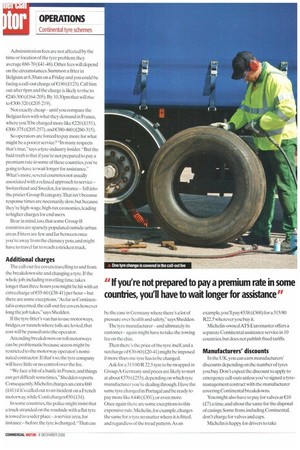ARONA HOESTR NG
Page 60

Page 62

If you've noticed an error in this article please click here to report it so we can fix it.
Punctures can bring even the most well-maintained trucks to a halt, so when you're across the water Ws nice to know help is at hand when and where you need
it Steve Banner investigates.
It's the call that is dreaded by every haulier on international work. -I'm just outside Milan, boss; it's lam and I've got two flat tyres. What do I do?"
Fortunately most of the major tyre manufacturers, including Michelin, Goodyear, Dunlop, Continental and Bridgestone.offer a 24/7 payas-you-go emergency roadside rescue service.
For example, every year Continental's ContiBreakdownService attends 1,200 tyre incidents involving UK-registered trucks on the Continent.
No matter which service he calls on, the stranded driver simply rings a freephone number and speaks to a multilingual control centre. Help will usually come in the shape of an independent truck tyre dealer who stocks the brand that's failed.The freephone number will be valid in most of Europe although a separate number might be needed in some countries.
"Quite often the driver will call his home depot before he calls us, or the home depot may contact us directly once it's been told that he's stuck," says Rebecca Shedden, Continental's Euro Service manager for the UK. "But we prefer to speak directly to the driver if at all possible so we can find out exactly what the difficulty is, and where he is "In places like Germany and Belgium we reckon to have you roiling again no more than three hours after we get the call," she adds. "In Spain and Italy, the drive-on time' as we call it is usually more like four hours "Cultural attitudes are a little bit different in Southern Europe compared to the UK they don't have a problem waiting until they've had their lunch before they attend a breakdown." Nonetheless,from next year Continental plans to offer operators compensation if targeted drive-on times aren't met.
European charging bands 'lyre manufacturers generally split Europe into two charging bands, often referred to as Group A -countries where response is usually reasonably rapidand Group B, where drivers may have to wait longer and prices are higher.
Group A typically includes Germany, the Benelux countries and Denmark. Group B is likely to embrace Italy, France. Spain and Portugal.Within each band the charges levied will be fixed and predictable, only varying if a fitter has to attend out of hours or on a Sunday or a public holiday.
The tyre company will verify and settle the bill submitted by whoever has carried out the work,then pass it on to the haulier translated into English,and in sterling either directly or through its local distributor.
Charges are generally broken down into the administration fee, the call-out fee, and the cost of the tyre; usually in euros and excluding VAT. 1111. Administration fees are not affected by the time or location of the tyre problem; they average €60-70 (£41-48).0ther fees will depend on the circumstances. Summon a fitter in Belgium at 8.30am on a Friday and you could be facing a call-out charge of €180 (£123). Call him out after 6pm and the charge is likely to rise to €240-3()0 (£164-205). By 10.30pin that will rise to €300-320 (£205-219).
Not exactly cheap until you compare the Belgian fees with what they demand in France, where you'll be charged more like €220 (£151), €300-375 (£205-257), and €380-460 (£260-315).
So operators are forced to pay more for what might be a poorer service? "In many respects that's true," says a tyre-industry insider.-But the bald truth is that if you're not prepared to pay a premium rate in some of these countries, you're going to have to wait longer for assistance." What's more, several countries not usually associated with a relaxed approach to service Switzerland and Sweden, for instance fall into the pricier Group B category.That isn't because response times are necessarily slow, but because they're high-wage, high-tax economies, leading to higher charges for end users.
Bear in mind, too, that some Group B countries are sparsely populated outside urban areas. Fitters are few and far between once you're away from the chimney pots, and might have to travel far to reach a stricken truck.
Additional charges
The call-out fee covers travelling to and from the breakdown site and changing a tyre. If the whole job, including travelling time, takes longer than three hours you might be hit with an extra charge of €55-60(08-41) per hourbut there are some exceptions. "As far as Continental is concerned, the call-out fee covers however long the job takes," says Shedder'.
If the tyre fitter's van has to use motorways, bridges, or tunnels where tolls are levied, that cost will be passed onto the operator.
Attending breakdowns on toll motorways can be problematic because access might be restricted to the motorway operator's nominated contractor. If that's so, the tyre company will have little or no control over the fee.
"We face a bit of a battle in France, and things can get difficult sometimes,"Shedden reports. Consequently,Michelin charges an extra €60 (141) if it's called out to an incident on a French motorway, while Conti charges €50 (£34).
In some countries, the police might insist that a truck stranded on the roadside with a flat tyre is towed to a safer place a service area, for instance before the tyre is changed. "That can




































































































































































































